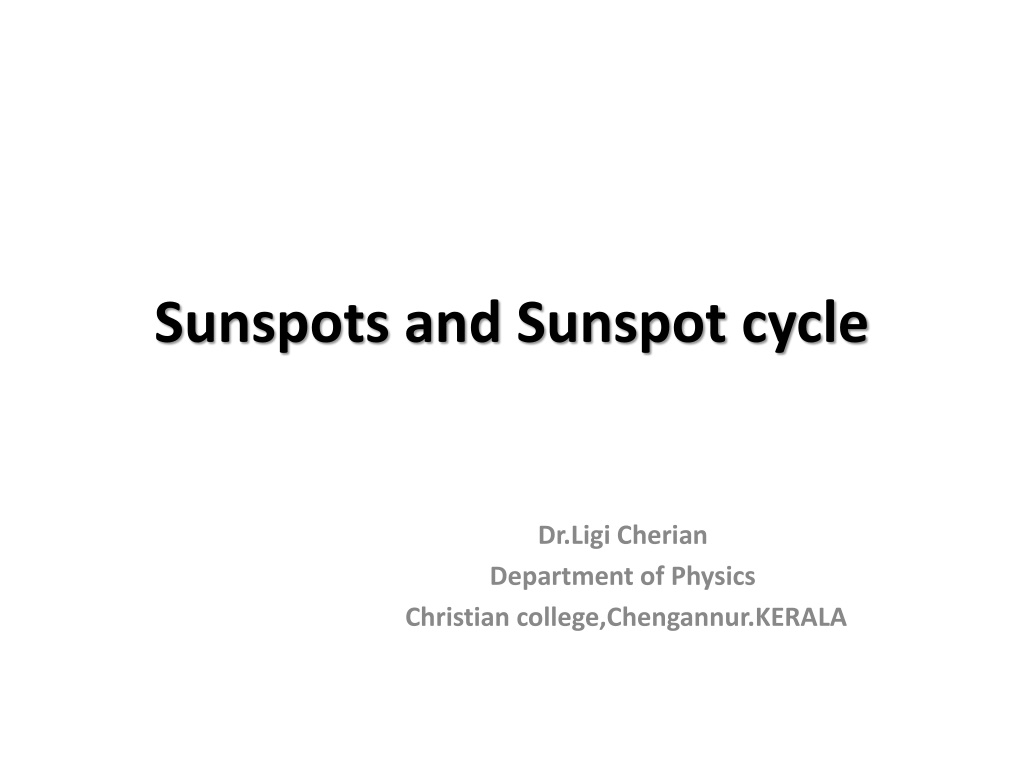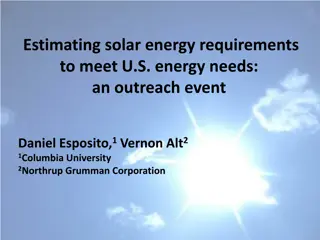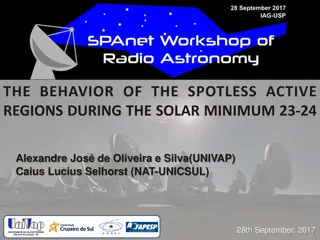Exploring Sunspots and the Solar Cycle
Sunspots are cooler, darker regions on the solar atmosphere with strong magnetic fields. They are mainly seen on the photosphere, which is the visible surface of the Sun. These dark spots are cooler than their surroundings, with temperatures around 4,000 K. Sunspots are formed due to the Sun's magnetic field generated by the motion of conductive plasma. The solar cycle, occurring approximately every 11 years, is characterized by changes in the Sun's magnetic field. Measurements of sunspot variations help determine the Sun's differential rotation rates.
Download Presentation

Please find below an Image/Link to download the presentation.
The content on the website is provided AS IS for your information and personal use only. It may not be sold, licensed, or shared on other websites without obtaining consent from the author. Download presentation by click this link. If you encounter any issues during the download, it is possible that the publisher has removed the file from their server.
E N D
Presentation Transcript
Sunspots and Sunspot cycle Dr.Ligi Cherian Department of Physics Christian college,Chengannur.KERALA
Sunspots??... Black spots seen on solar atmosphere Cooler regions on solar atmosphere Strong magnetic field regions on solar atmosphere
Solar atmosphere ?? Four Regions 1. Core 2. Photosphere 3. Chromosphere 4. Corona Sunspots are seen on photosphere Photosphere-What we see as Sun
Sunspots are "dark" because they are cooler than their surroundings. A large sunspot might have a central temperature of 4,000 K (about 3,700 C or 6,700 F), much lower than the 5,800 K (about 5,500 C or 10,000 F) temperature of the adjacent photosphere
Solar magnetic field Generated by the motion of conductive plasma inside sun. This motion is created through convection A localized magnetic field exerts a force on the plasma, effectively increasing the pressure without a comparable gain in density. As a result, the magnetized region rises relative to the remainder of the plasma, until it reaches photoshere. This creates sunspots
Magnetic flux tubs are formed within a sun's Convection zone Due to the differential rotation of the star, the tube becomes curled up and stretched, inhibiting convection and producing zones of lower than normal temperature. Coronal loops often form above sunspots, forming from magnetic field lines that stretch out into the corona
Measurements of the time variation in sunspot number can be useful for determining the differential rotation rates of sun
The solar cycle is the cycle that the Sun's magnetic field goes through approximately every 11 years. The Sun'smagnetic field goes through a cycle, called the solar cycle.
The 11-year sunspot cycle is actually half of a longer, 22-year cycle of solar activity. Each time the sunspot count rises and falls, the magnetic field of the Sun associated with sunspots reverses polarity; the orientation of magnetic fields in the Sun's northern and southern hemispheres switch.
Experimental Synthesis of An isotropic Plasmonic systems In the direct chemical reduction scheme, anisotropic silver nanoparticles were successfully prepared at room temperature. The formation of anisotropic silver nanoparticles (Ag NPs) was obtained by the reduction of silver ion to silver from silver nitrate by a reducing agent sodium borohydride. This shape formation was controlled by trisodium citrate (TSC) and hydrogen peroxide (H2O2). The formation of anisotropic nano particles can be observed through the colour change of the solution. During the reduction process, the solution colour changed to yellowish after one minute. The colour continued to change for five minutes until the colour remained dark blue.Figure 1 shows the colour change of the prepared anisotropic solution. The formation of anisotropic AgNPs was preliminarily characterized by visual observation of the change in color of the solution. UV-visible absorption spectra were recorded in the range 300-900 nm using a Jasco (V-560) model double beam spectrophotometer. The size and morphology of AgNPs were examined by transmission electron microscopy .
Fig 1 : Colour change of the synthesised anisotropic Ag NPs.
Photo catalytic activity In the current study, the photocatalytic activity of the synthesised AgNPs was tested in terms of its efficacy to photocatalytically degrade MB dye. Photocatalytic degradation of MB dye at a concentration of 50 mg/L was carried out in 100 mL of aqueous solution using 2 mg of the synthesised AgNP powder. The reaction mixture was continuously stirred using magnetic stirrer under bright solar irradiation. To test for any possible solar photolytic reaction, a control batch experiment was conducted under sunlight in the absence of AgNPs by maintaining the similar conditions as that of photocatalytic degradation experiments. An experiment was also conducted in the presence of AgNPs but under dark conditions, to test for any possible adsorption of the dye. Samples were withdrawn from the reaction mixtures at regular intervals of time and the dye concentration was determined through absorbance measurement at a wavelength of 614 nm using UV vis spectrophotometer and the precalibrated data. Percentage dye removal or degradation was calculated using the relation where Co is the initial dye concentration and C is the dye concentration at any time during the reaction.
Thermal lensing Experimental Ultra-sensitive dual beam mode matched TL technique was used to measure non radiative decay and thermal diffusivity. A 532 nm diode pumped solid state laser (DPSS) with a maximum power of 150 mW was used as the excitation source and a 2mW He-Ne laser used as the probe. The two beams were focused in to the sample cell such that the beam area at the sample plane was the same for both pump and probe resulting in a mode matched TL configuration. Attenuators were used for adjusting the power at the sample to avoid aberrations.
Results and Discussions In present report direct chemical reduction scheme was employed for the synthesis of anisotropic systems. Anisotropic systems of silver are typically prepared by reducing an aqueous solution of silver nitrate (AgNO) with sodium boro hydride (NaBH4) in the presence of trisodium citrate (TSC). The UV-vis absorption spectra of nanofluids containing silver nanoparticles possessing different shapes prepared at concentration of 1.5mM with different particle shapes was shown in Fig. * Without the addition of H2O2, only quasi-spherical silver nanoparticles can be obtained after about 1 min of reaction, as indicated by the color of as-prepared solution(Figure*). When the concentration of H2O2 was increased to 2 mM, a sharp peak around 450 nm appeared (Figure 2a), suggesting the formation of both plate-like structures and spherical nano particles, which has also been confirmed by TEM characterization. The sharp characteristic peak of silver nanoparticles at ~400 nm disappeared as the concentration of H2O2 was increased to 7 mM. When the concentration of H2O2 was further increased to 15 mM, the the dipole resonance redshifted to ~600 nm. To investigate the detailed formation process of the silver nano plates, we monitored the change in the SPR peak and evaluated the variation in band gap during growth and nucleation of anisotropic systems. Upon the addition of NaBH4, colorless solution became light yellow immediately, suggesting the formation of isotropic silver nano particles. After 1 min of reaction, the light yellow solution turned deep yellow in the span of several seconds, suggesting the complete formation of spherical silver nanoparticles
Fig 2: UV-Visible spectrum of anisotropic silver nanoparticles
The change in the optical property of the colloidal solution was recorded using a UV/vis spectrometer. Upon addition of H2O2, color of the solution then quickly changed from deep yellow to red, green, and finally blue, as evidenced by the Figure 1. The corresponding UV/vis spectra is shown in Figure 2. Intensity of the peak of spherical nanoparticles decreased gradually and another peak at 500 nm emerged and red-shifted to longer wavelengths, implying the formation and growth of anisotropic systems. The formation and development of anisotropic silver nano systems are completely governed by addition of H2O2 and the reactions took about 1-3 min. A video showing the real time monitoring of the corresponding formation of an isotropic systems is provided in the Supporting Information.
Shape dependent Non linear Optical Properties of Anisotropic silver To evaluate the effect of morphology of plasmonic particles on the thermo-optic parameter thermal diffusivity, a dual beam mode- matched thermal lens experimental technique was used . A TEM00 Gaussian laser beam as the excitation source. The heating crated due to non radiative decay process, will increase the temperature. The heating creates a temperature gradient and hence a refractive index gradient. Symmetry of refractive index gradient, makes a diverging lens out of the sample( Fig.5).
beam intensity becomes more practical. According to the theory of thermal lensing, the focal length f of the TL formed in a liquid when a cw laser beam is passed through it at t = 0 is given by In a mode matched pump probe collinear arrangement, measurement of time dependent Where , p is the wavelength of the probe beam, D and K are the thermal diffusivity and thermal conductivity, Pe is the excitation beam power, is the linear absorption coefficient and l is the sample thickness.zc= 02/ is the confocal distance(cm), 0 is the probe beam waist radius, p and e are the probe and excitation beam radii at the sample respectively. Figure 6(a) - 6(f) shows the normalized TL time evolution signal, I(t)/I(0) of the samples. TL setup is quite accurate in measuring this thermal parameter. Similar TL evolution signals were obtained for fluid of other anisotropic silver nanoparticle shapes and their corresponding h s, tc s, and D s were tabulated in Table 2. From the obtained results, as shown in Fig. 6(a)- 6(f), it is clear that fluid thermal diffusivity varies with nanoparticle shape. Most of the light (532 nm) absorption and conversion to heat is by silver nanoparticles that produce phonon following the surface plasmon process and thus the particles become heat source. The light absorption and conversion into heat is by transforming from low to high kinetic energy silver ions and citrate molecules but in less efficient way due to small absorbance. A proper interpretation for the increase in thermal diffusivity with change of particle shape is due to phonon scattering at interface or transfer of energy from nanoparticles to liquid. When the particle shape changes, more and more anisotropic, the phonon scattering transfers more energy to the surrounding liquid. The other reason can be related to good contact between the increased surface area of the anisotropic nanoparticles and the surrounding liquid.























